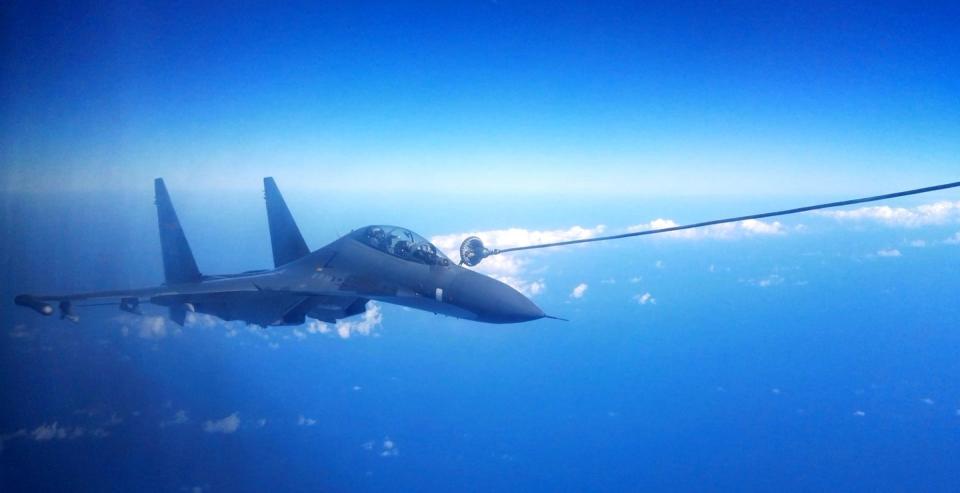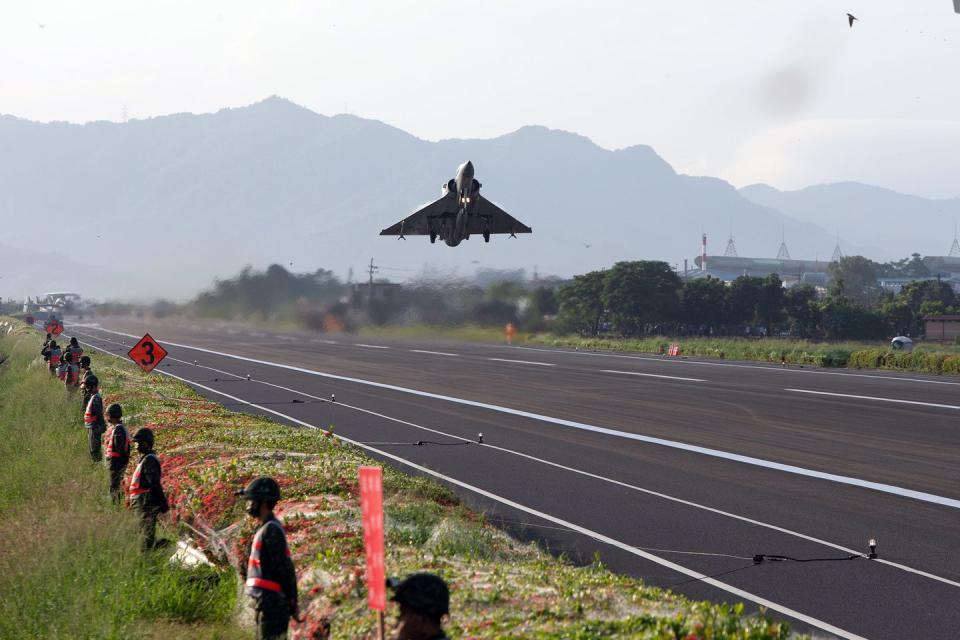China Sent Nearly 150 Aircraft Near Taiwan's Airspace Across 4 Days of Incursions
Over the weekend, the Chinese Air Force repeatedly sent large numbers of fighters, bombers, and support aircraft into Taiwan's Air Defense Identification Zone.
The flights are designed to intimidate Taiwan, which considers itself separate from mainland China.
Over the summer, China sent a record number of warplanes to Taiwan's coast. The latest maneuvers show China ramping up those efforts.
The People's Republic of China dramatically ramped up military pressure on Taiwan over the weekend, flying successively larger numbers of warplanes near the breakaway island republic. The flights—conducted over a four-day period between between Friday, October 1 and Friday, October 4—broke records each day for the number of aircraft involved, totaling nearly 150. The planes flew into Taiwan's Air Defense Identification Zone (ADIZ), but did not overfly the island or its sovereign airspace.
Taiwan's Defense Minister, Chiu Kuo-cheng, said Wednesday that the wave of flights marked "the most serious" military tension between China and Taiwan in more than 40 years, according to Reuters.
✈︎ Don't miss our best-in-class military coverage. Join our squadron.
On October 1, China's National Day, two waves of aircraft flew near Taiwan's airspace; the first maneuver included 25 jets, and the second one involved an additional 13 planes. In total, the aerial flotilla included 28 Shenyang J-16 multirole fighters, six Russian-made Su-30 multirole fighters, two Xian H-6 long-range bombers, one Shaanxi Y-8 anti-submarine warfare plane, and one Shaanxi KJ-500 airborne early warning aircraft.
The number of planes totaled 38, making this China's largest incursion to date, surpassing the previous record from June 15 of this year. Back then, a combined force of 28 fighters, bombers, airborne control, and electronic warfare aircraft lifted off from bases on the mainland and crossed the Taiwan Strait.
In response to the October 1 events, Taiwan had combat air patrol fighters monitor the aircraft. The island's response also included "radio warnings issued, and air defense missile systems deployed, to monitor the activity," according to an October 2 bulletin from Taiwan's Ministry of National Defense.
On Saturday, October 2, China topped that number, sending 26 J-16s, 10 Su-30s, one KJ-500, and two Y-8s for a total of 39 aircraft. Taiwan's defense forces reported the same response.
On October 3, the People's Liberation Army Air Force sent 16 aircraft toward Taiwan's airspace—a brief respite before sending its largest force ever into Taiwan's ADIZ on October 4. That sortie included 56 total aircraft: 38 J-16s, two Su-30s, two Y-8s, two KJ-500s, and 12 H-6 bombers.
52 PLA aircraft (J-16*34, SU-30*2 Y-8 ASW*2, KJ-500 AEW&C*2 and H-6*12) entered #Taiwan’s southwest ADIZ on October 4, 2021. Please check our official website for more information: https://t.co/2mC6UszTMB pic.twitter.com/WOtdFvJx8o
— 國防部 Ministry of National Defense, R.O.C. 🇹🇼 (@MoNDefense) October 4, 2021
The flights are part of a pressure campaign designed to demoralize Taiwan's population—and by extension, military forces—with overwhelming displays of military power. Taiwan, which broke away from mainland China in 1949 after the end of the Chinese Civil War, sees itself as the legitimate (and democratic) government, as opposed to the Chinese Communist Party's rule from Beijing. Beijing considers Taiwan a renegade province. In the U.S., a similar scenario might look like Florida seceding from the Union, while declaring itself the rightful government over Washington, D.C.

Historically, Beijing has considered the Taiwan issue the most important foreign policy (or domestic policy) issue on its plate. In the past, it has preferred a peaceful reunification of the two Taiwans, but has never ruled out forcefully repatriating the island. Under current ruler Xi Jinping, China has become more aggressive toward Taiwan and other neighbors, and has built up and modernized the air, land, and sea forces necessary to invade and occupy the island.
Some news outlets have referred to the flights as airspace violations, which is factually incorrect. Under international law, each country can claim sovereign airspace out to 12 nautical miles from its coastline. Airspace violations are a serious matter and could be considered an act of war.
Extremely quick and dirty job on this but it's just supposed to make the point: in red is Taiwan's sovereign airspace. In white is the ADIZ. Whipped this up because to my surprise no one had made this before (at least that I've seen) pic.twitter.com/3lrwAwUioY
— Decker Eveleth (@dex_eve) October 4, 2021
This weekend's Chinese Air Force flights, however, were into Taiwan's Air Defense Identification Zone. An ADIZ is a zone that a country declares is of interest to its air defense forces. It can easily be several hundred miles wide to give a country's air force time to scramble and intercept planes that could conceivably fly on to penetrate friendly airspace. Taiwan's zone, as shown above by open source intelligence researcher Decker Eveleth, actually extends into China's airspace and deep into the country's interior.
Although Taiwan's ADIZ extends into China, it doesn't make a big deal about nearby Chinese military flights unless they venture to the median line between the mainland and the island itself. The Taiwan Strait is only 100 miles apart, so once a Chinese warplane crosses the median line, it's 50 miles from the island.

China would vastly prefer to bring Taiwan back into the fold without fighting, but in the meantime is preparing its armed forces for a fight. This weekend's muscle-flexing is designed to convince Taiwan of China's overwhelming military power. That, and the idea that it is futile to resist re-assimilation.
If that fails, China may continue to peacefully pursue reunifications—or one day, the planes may fly up to the median line over the Taiwan Strait and keep going.
🎥 Now Watch This:
You Might Also Like

